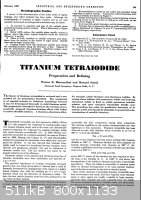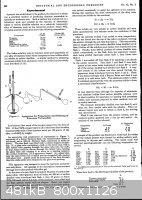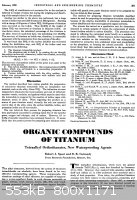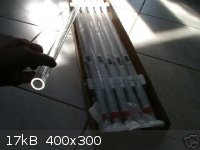| Pages:
1
2 |
plante1999
International Hazard
    
Posts: 1936
Registered: 27-12-2010
Member Is Offline
Mood: Mad as a hatter
|
|
sorry for the double post , if i made TiCl4 i can reacting it with HF :
TiCl4 + 4NaF -> 4NaCl + TiF4
and i am in working to find a way to make some TiCl4 with the apparatus i described at my last post.
I never asked for this.
|
|
|
Jor
National Hazard
   
Posts: 950
Registered: 21-11-2007
Member Is Offline
Mood: No Mood
|
|
I am also gonna try to make TiI4 this day or tomorrow. I will use dichloromethane instead of chloroform as a solvent (I only have about 60mL of
chloroform, I have 350mL CCl4 but thats only more toxic). I see you reflux your chloroform during reaction. Do you know if the reaction also proceeds
nicely at RT?
I will be using very fine titanium turnings, but not really a powder.
Because with DCM I can't reach the reflux temp of chloroform I wonder if the reaction will proceed.
In any case I will wash the titanium with 0,1M HCl containing some NaF untill a good amount of H2 evolves, then I will decant, rinse with small amount
of water, acetone (or IPA) and finally DCM to activate the material.
[Edited on 15-4-2011 by Jor]
|
|
|
plante1999
International Hazard
    
Posts: 1936
Registered: 27-12-2010
Member Is Offline
Mood: Mad as a hatter
|
|
if you lets it for 1-4 week it will work at rt( i already have tested it) but if you want to make it in a day or so it should be very hot or refluxing
, washing is nessecary. try to dilute as mush you can your solution , and than boil it to get the crystal, or the restion is very hard to see.
good luck!!
I never asked for this.
|
|
|
Mixell
Hazard to Others
  
Posts: 449
Registered: 27-12-2010
Member Is Offline
Mood: No Mood
|
|
My metals and iodine are going to arrive soon.
I don't have any chloroform, is there any way to perform such reaction(synthesis TiI4, SnI4) without a solvent?
possibly using an excess of iodine and then just boiling the iodine away?
I got a good amount of acetone, but I think it will react with the substance and cannot be used as a solvent...
[Edited on 3-7-2011 by Mixell]
|
|
|
The WiZard is In
International Hazard
    
Posts: 1617
Registered: 3-4-2010
Member Is Offline
Mood: No Mood
|
|
Titanium tetraiodide from Industrial and Engineering Chemistry
Picked this ref up in Brauer (la book is in the forums library).
He mentions this method among others.
Because this is from a bound volume I had to take a scalpel
to it and remove the pages for scanning. No extra charge.
  
|
|
|
Mixell
Hazard to Others
  
Posts: 449
Registered: 27-12-2010
Member Is Offline
Mood: No Mood
|
|
Thank you for the post wizard.
I guess its decided, I'll use an excess of iodine. The titanium/iodine mix will be heated in a sealed vessel (with a pop-up stopper) to about
125-130C. After the reaction is completed, the vessel will be heated to 185-200C and all of the excess iodine will be evaporated. And it should leave
a quite pure TiI4.
Hope the shipment will arrive soon...
|
|
|
The WiZard is In
International Hazard
    
Posts: 1617
Registered: 3-4-2010
Member Is Offline
Mood: No Mood
|
|
Quote: Originally posted by Mixell  | Thank you for the post wizard.
I guess its decided, I'll use an excess of iodine. The titanium/iodine mix will be heated in a sealed vessel (with a pop-up stopper) to about
125-130C. After the reaction is completed, the vessel will be heated to 185-200C and all of the excess iodine will be evaporated. And it should leave
a quite pure TiI4.
Hope the shipment will arrive soon... |
I would suggest reading Brauer's Handbook of Preparative
Inorganic Chemistry, p. 1205-09. Titanium (IV), Zirconium (IV)
and Thorium (IV) Iodides. The book can be DL'd. It is in
the library where science is often most mad. Granted his methods
are nuanced... big time!
|
|
|
Mixell
Hazard to Others
  
Posts: 449
Registered: 27-12-2010
Member Is Offline
Mood: No Mood
|
|
After successfully synthesizing SnI4, I'm planning to venture into the more slower reacting metals, such as titanium, tantalum, tungsten and niobium.
I;m planning to start with titanium, but I would very much like to replace chloroform with another solvent, like hexane. Is it possible? or the iodine
will react with the hexane to form HI and some iodinated derivatives of the hexane with the formula C6I(n)H(14-n)?
Also, after I will be done with the titanium I'm planning to try tungsten, but I didn't found any information on WI6 (as opposed to WCl6) but found
some info about WI4 and WI2, which one of this species would be created in a solution of iodine at room temperature?
And finally, as I mentioned, I'm planning to do the reaction at room temperature, I got time (weeks and even more) to wait for it to fully react, but
will the reaction proceed at this temperature at all?
|
|
|
blogfast25
International Hazard
    
Posts: 10562
Registered: 3-2-2008
Location: Neverland
Member Is Offline
Mood: No Mood
|
|
I'm not sure whether iodine is capable of halogenating heptane at RT. If so, yields will be poor, I predict. A question for the organikers, I feel...
WCl6 can be synthesised by direct union of the elements but it takes higher than RT temperatures to so so. I strongly suspect this might also be the
case for any iodides. WI6 may be a bit of a stretch (no pun intended): to fit 6 quite large iodine atoms 'around' one just barely larger tungsten atom
may be pushing it a bit?
|
|
|
Mixell
Hazard to Others
  
Posts: 449
Registered: 27-12-2010
Member Is Offline
Mood: No Mood
|
|
So probably WI4 is the species that will be produced at this reaction. May be dissolve some iodine in hexane and let it stand for a few days or weeks?
If the iodinated species of hexane are colorless, then if the solution will turn colorless or the purple color will faint, then it means that the
hexane was iodinated.
Bromination of hexane seems to be quite quick at RT, so I guess iodination will proceed too, seems like chloroform is the better option after all.
[Edited on 13-8-2011 by Mixell]
|
|
|
blogfast25
International Hazard
    
Posts: 10562
Registered: 3-2-2008
Location: Neverland
Member Is Offline
Mood: No Mood
|
|
Yes on the heptane/iodine.
Re. WI4, apparently it decomposes before melting which would suggest low temperature synthesis. What will be your source of tungsten?
|
|
|
Mixell
Hazard to Others
  
Posts: 449
Registered: 27-12-2010
Member Is Offline
Mood: No Mood
|
|
Tungsten powder.
There is also a WI2 species, although I didn't find much information about it.
|
|
|
Morgan
International Hazard
    
Posts: 1663
Registered: 28-12-2010
Member Is Offline
Mood: No Mood
|
|
Ti + 2 I2 → TiI4
"This reaction can be reversed to produce highly pure films of Ti metal.[4]"
http://en.wikipedia.org/wiki/Titanium_tetraiodide#cite_note-...
Would it be possible to make a thin film of titanium inside of a quartz tube via TiI4 vapor deposition followed by thermal decomposition of the
titanium tetraiodide? I wonder if it would stick or react with the quartz in some way?
|
|
|
tetrahedron
Hazard to Others
  
Posts: 210
Registered: 28-9-2012
Member Is Offline
Mood: No Mood
|
|
at the very least the Ti film being a metal probably expands a lot upon heating, stressing the more rigid quartz substrate (if that's the use you have
in mind).
|
|
|
Morgan
International Hazard
    
Posts: 1663
Registered: 28-12-2010
Member Is Offline
Mood: No Mood
|
|
Basically, I just wanted to coat the inside of one of these quartz tubes I have with a very thin film of titanium dioxide ultimately to create some
pretty colors playing on the interference of light.
It was just something I thought might be fun to try, anodizing the titanium coating into an artistic "Peter Max" effect if you will.
That is a good point about the coefficient of expansion between SiO2 and Ti.

|
|
|
Morgan
International Hazard
    
Posts: 1663
Registered: 28-12-2010
Member Is Offline
Mood: No Mood
|
|
Materials and procedure for TiI4 - A major motion picture of glassware.
http://pubs.acs.org/doi/abs/10.1021/ja01201a006
|
|
|
Morgan
International Hazard
    
Posts: 1663
Registered: 28-12-2010
Member Is Offline
Mood: No Mood
|
|
"The gaseous metal tetraiodide is decomposed on a white hot tungsten filament (1400 °C). As more metal is deposited the filament conducts better and
thus a greater electric current is required to maintain the temperature of the filament. The process can be performed in the span of several hours or
several weeks, depending on the particular setup."
http://en.wikipedia.org/wiki/File:Titan-crystal_bar.JPG
http://en.wikipedia.org/wiki/Crystal_bar_process
|
|
|
watson.fawkes
International Hazard
    
Posts: 2793
Registered: 16-8-2008
Member Is Offline
Mood: No Mood
|
|
Quote: Originally posted by tetrahedron  | | at the very least the Ti film being a metal probably expands a lot upon heating, stressing the more rigid quartz substrate (if that's the use you have
in mind). |
That's unlikely to be much of a problem in this case. There about a 10^4:1 thickness ratio between
the glass and a thin metal film. There will be an interfacial force, still, but that's the stress. The strain will predominantly deform the film
(compressing it as it heats up) rather than the glass. The risk is not breaking the glass, but delaminating the film. I would guess that Ti bonds
fairly tightly, as its inner layer would partially oxidize and meld with the glass matrix.
|
|
|
Morgan
International Hazard
    
Posts: 1663
Registered: 28-12-2010
Member Is Offline
Mood: No Mood
|
|
A method of TiO2 deposition on glass, not enough color for my purposes though and a rather involved process.
Lab Report: Dr Charlie Dunnill on chemical vapour deposition
http://www.youtube.com/watch?v=KjjQf12FgUQ
I would like something more like this though it would be nice to produce less kitsch-like colors or isolate a few colors and patterns that work well
together.
Anodizing Titanium and Niobium: Science and Art Combined
http://www.youtube.com/watch?v=OzShFSj3xxA#t=1m26s
Loud creations made by vaporizing titanium in a vacuum I believe. Not a route I could afford.
https://www.google.com/search?q=titanium+quartz&hl=en&am...
Titanium films
"There have been many studies which have concluded that the adhesion of metal films to oxide substrates is directly related to the free energy of
oxide formation of the deposited material. That being the case, very strong adhesion should occur for titanium to the quartz substrate. A titanium
film was sputter deposited on a quartz substrate."
http://ntrs.nasa.gov/archive/nasa/casi.ntrs.nasa.gov/1976001...
[Edited on 17-11-2012 by Morgan]
|
|
|
| Pages:
1
2 |